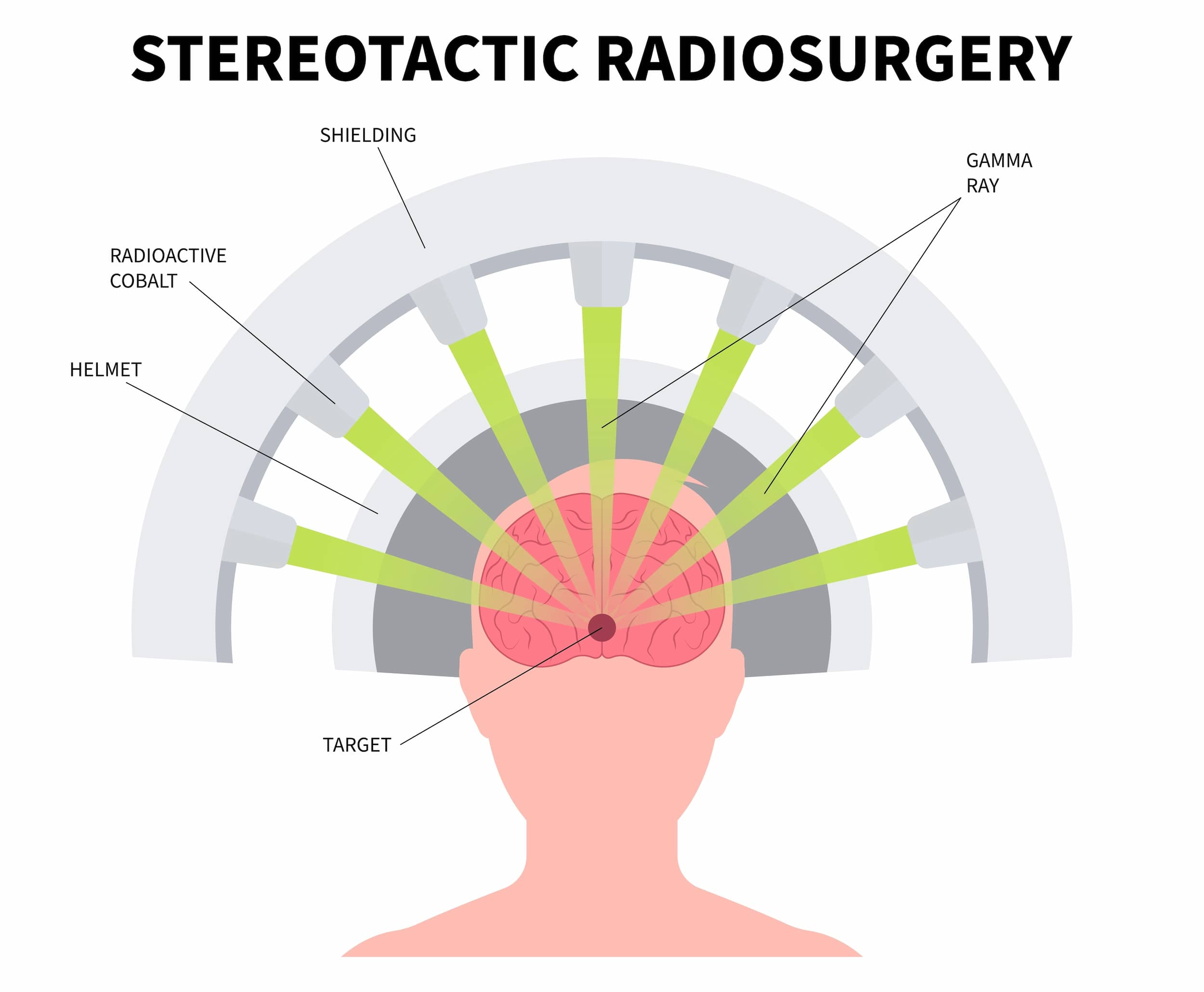What is Stereotactic Radiosurgery?
Stereotactic Radiosurgery (SRS) is a highly advanced, non-invasive procedure used to treat brain and spine tumors, as well as other neurological conditions. It involves the use of focused radiation beams that are directed with pinpoint precision at the target area, allowing doctors to treat tumors without making an incision. Unlike traditional surgery, SRS does not require a hospital stay or extended recovery time, making it a safer and more comfortable option for many patients.
Key Objectives of Stereotactic Radiosurgery:
- Precise Tumor Treatment: The main goal of SRS is to deliver high doses of radiation to tumors in the brain and spine while minimizing damage to surrounding healthy tissues.
- Minimize Risk and Side Effects: By targeting only the tumor, SRS reduces the risk of complications and side effects commonly associated with conventional surgery.
- Non-Invasive Solution: SRS is a non-surgical procedure, making it an ideal option for patients who are not candidates for traditional surgery due to tumor location or health conditions.
Why Choose India for Stereotactic Radiosurgery?
India has become a leading destination for advanced treatments like Stereotactic Radiosurgery, offering world-class medical facilities, highly experienced neurosurgeons, and affordable treatment options. The country provides patients with access to state-of-the-art technology for precise tumor treatment, all while keeping the costs significantly lower compared to Western countries.
Key Advantages of Choosing India:
- Affordable Treatment: Stereotactic Radiosurgery in India can cost up to 70% less than in countries like the US, without compromising on quality.
- Experienced Surgeons: India boasts a number of world-renowned neurosurgeons specializing in SRS, with vast experience in treating complex brain and spine conditions.
- Advanced Technology: Accredited hospitals in India are equipped with the latest radiosurgery machines, such as the Gamma Knife and CyberKnife, for delivering precision radiation.
- Comprehensive Medical Tourism Support: Healtour Solutions ensures a seamless experience from initial consultation to post-treatment care, helping you throughout your medical journey.
Types of Tumors Treated with Stereotactic Radiosurgery:
Stereotactic Radiosurgery is primarily used for treating tumors that are difficult to reach through conventional surgery. Some of the common tumors treated with SRS include:
- Brain Tumors: Including gliomas, meningiomas, metastatic tumors, and pituitary adenomas.
- Spinal Tumors: Tumors affecting the spinal cord or vertebrae, including metastases and primary spinal tumors.
- Arteriovenous Malformations (AVMs): Abnormal tangles of blood vessels in the brain.
- Trigeminal Neuralgia: A painful condition affecting the trigeminal nerve.
- Acoustic Neuromas: Tumors on the vestibulocochlear nerve affecting balance and hearing.
Symptoms Indicating the Need for Stereotactic Radiosurgery
Stereotactic Radiosurgery is often recommended when patients experience symptoms related to tumors in the brain or spine. Some common symptoms include:
- Severe Headaches or Migraines: Unexplained headaches that do not respond to typical treatments could indicate a brain tumor.
- Seizures: New-onset seizures or changes in seizure patterns could be related to brain tumors.
- Vision Problems: Tumors near the visual centers of the brain can cause blurred vision, double vision, or loss of vision.
- Balance and Coordination Issues: Tumors affecting the cerebellum can lead to difficulties with coordination and balance.
- Neck or Back Pain: Tumors affecting the spine may cause persistent neck or back pain.
- Numbness or Weakness: Loss of sensation or strength in the limbs could be related to spinal tumors pressing on nerves.
The Procedure for Stereotactic Radiosurgery
The Stereotactic Radiosurgery procedure typically follows these steps:
Pre-Surgical Consultation:
- The patient undergoes a detailed consultation with the neurosurgeon, including imaging studies (MRI/CT scans) to assess the tumor's size, location, and type.
- A personalized treatment plan is created based on the tumor's characteristics and the patient's overall health.
Step-by-Step Process:
- Preparation: A special head frame or mask is fitted to help guide the precise delivery of radiation. This is a painless procedure, and the frame or mask ensures the head remains perfectly still during the treatment.
- Radiation Delivery: Using advanced equipment like Gamma Knife or CyberKnife, the radiation beams are precisely targeted at the tumor, sparing healthy tissues. The process usually takes 1-2 hours.
- Post-Treatment Care: The procedure is typically outpatient, and patients can return home the same day. Mild side effects such as fatigue or headache may occur but generally resolve after a few days.
Benefits of Stereotactic Radiosurgery
- Non-Invasive Treatment: Stereotactic Radiosurgery is a non-surgical procedure, eliminating the need for incisions and long recovery times.
- High Precision: SRS allows for highly accurate targeting of tumors, minimizing damage to healthy brain and spinal tissue.
- Quick Recovery: Unlike traditional surgery, patients can typically resume normal activities within a few days after treatment.
- Reduced Complications: Because there are no incisions, there is a lower risk of infection, bleeding, or other surgical complications.
Why Choose Healtour Solutions for Stereotactic Radiosurgery?
Healtour Solutions offers comprehensive support for patients seeking Stereotactic Radiosurgery in India. Our goal is to connect you with the best surgeons and hospitals for the best possible treatment and care.
Why Choose Us:
- Expert Care: We partner with experienced neurosurgeons who specialize in SRS procedures.
- Cost-Effective Options: We help you access affordable SRS treatments, reducing the financial burden of this advanced procedure.
- World-Class Hospitals: We ensure you receive treatment at accredited hospitals equipped with cutting-edge technology for SRS.
- Seamless Experience: From consultation to post-treatment recovery, we offer end-to-end support for international patients, making your journey smooth and stress-free.
Post-Treatment Recovery and Care
While recovery from Stereotactic Radiosurgery is generally quick, it's essential to follow a few basic guidelines:
- Immediate Aftercare: After treatment, most patients can go home the same day. Rest is recommended to allow the body to recover.
- Follow-Up Appointments: Regular follow-up visits are necessary to monitor the tumor's response to radiation and ensure proper healing.
- Possible Side Effects: Patients may experience mild headaches, fatigue, or swelling, but these usually resolve on their own.
- Lifestyle Modifications: Patients should avoid strenuous activities for a short period after the procedure.
Frequently Asked Questions (FAQs)
- What is Stereotactic Radiosurgery?
Stereotactic Radiosurgery (SRS) is a non-invasive procedure that uses focused radiation beams to treat brain and spine tumors with high precision. - Is Stereotactic Radiosurgery painful?
No, SRS is a painless procedure. The patient is usually awake during treatment, and a special head frame or mask ensures the head remains still. - How long does Stereotactic Radiosurgery take?
The procedure typically takes between 1 to 2 hours, depending on the size and location of the tumor. - What tumors can be treated with Stereotactic Radiosurgery?
SRS is used to treat brain tumors, spinal tumors, arteriovenous malformations (AVMs), trigeminal neuralgia, and more. - How soon can I return to normal activities after Stereotactic Radiosurgery?
Most patients can return to normal activities within a few days, as recovery time is minimal. - Are there any risks associated with Stereotactic Radiosurgery?
SRS has minimal risks, including mild side effects like headaches or fatigue, which usually resolve within a few days. - How effective is Stereotactic Radiosurgery?
SRS is highly effective, offering a high success rate in treating tumors with minimal side effects and no need for traditional surgery. - Is Stereotactic Radiosurgery covered by insurance?
Coverage varies by insurance provider, but many international insurers cover SRS treatment for brain and spine tumors. - How long do I need to stay in the hospital after Stereotactic Radiosurgery?
Stereotactic Radiosurgery is usually an outpatient procedure, meaning patients can return home the same day. - Can Healtour Solutions help with my Stereotactic Radiosurgery?
Yes, Healtour Solutions provides comprehensive support for Stereotactic Radiosurgery, including surgeon consultation, hospital selection, and travel arrangements.




